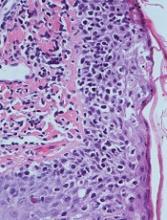LONDON—Results of a phase 2 trial suggest the topical histone deacetylase (HDAC) inhibitor remetinostat can elicit responses in patients with early stage mycosis fungoides (MF).
At the highest dose level tested, remetinostat gel reduced the severity of skin lesions in 40% of patients and reduced the severity of pruritus in 80% of patients.
In addition, the HDAC inhibitor was considered well tolerated and did not produce systemic adverse effects.
These results were presented at the European Organization for Research and Treatment of Cancer Cutaneous Lymphoma Task Force meeting, which took place October 13-15.
The study was sponsored by Medivir AB, which purchased remetinostat from TetraLogic Pharmaceuticals last year.
The trial of remetinostat enrolled 60 patients with stage IA-IIA MF across 5 clinical sites in the US. Patients were randomized to receive remetinostat gel 0.5% twice daily, remetinostat gel 1% once daily, or remetinostat gel 1% twice daily for up to 12 months.
The study’s primary endpoint was the proportion of patients with a confirmed response to therapy, assessed using the Composite Assessment of Index Lesion Severity.
The researchers observed a dose response, with patients in the 1% twice-daily arm having the highest proportion of confirmed responses.
Based on an intent-to-treat analysis, confirmed response rates were as follows:
| Dose arm | Number of patients per arm | Number of responders (complete responders) | % of patients with a response |
| 1% twice daily | 20 | 8 (1) | 40% |
| 0.5% twice daily | 20 | 5 (0) | 25% |
| 1% once daily | 20 | 4 (0) | 20% |
The researchers also assessed the effect of remetinostat gel on the severity of pruritus. This was assessed monthly for the duration of the study using the visual analogue scale.
Among patients with clinically significant pruritus at baseline, those who received remetinostat gel 1% twice daily were most likely to have a clinically significant reduction in pruritus. This was defined as at least a 30 mm reduction in the visual analogue scale score sustained for more than 4 weeks.
The proportion of patients who had confirmed, clinically significant reductions in pruritus from baseline was 80% in the 1% twice-daily arm, 50% in the 0.5% twice-daily arm, and 37.5% in the 1% once-daily arm.
The researchers said remetinostat was generally well tolerated, with adverse events evenly distributed across the treatment arms. The most common adverse events were skin-related and mostly grade 1-2.
There were no signs of systemic adverse effects related to remetinostat, including those associated with systemic HDAC inhibitors.
Most patients remained on study for the maximum possible duration, and the median treatment time was 350 days.
Based on the outcomes of this study, Medivir expects to meet with regulatory authorities to discuss the design of a pivotal clinical program for remetinostat in MF.


